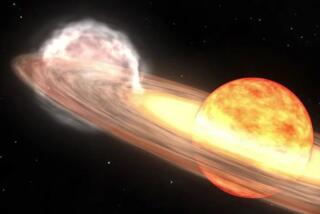Solar storm expected to spur amazing northern lights: How to see them
- Share via
Forget the polar vortex and turn your eyes to the sky -- if you live in the right latitudes to catch the northern lights tonight.
Scientists at the National Oceanic and Atmospheric Administration say there’s a 90% chance of a strong geomagnetic storm on Thursday that will cause skies in northern latitudes to light up in brilliant and beautiful shades of greens and reds.
The storm could be strong enough that the auroras will be visible as far south as Chicago, Cleveland and other parts of the continental United States that aren’t usually privy to such events. Researchers at NOAA are predicting that the lights will be visible along the yellow K=7 line in the map above.
(Sorry, friends in SoCal and other parts of the southern U.S. -- we’ll have to watch the auroras vicariously through photos uploaded to Twitter).
According to NOAA, the auroras will be brightest at midnight, so the best time to look for them is between 10 p.m. and 1 a.m. local time. They can be drowned out by ambient lights, so the best views will be as far from city lights as you can get. Cloudy skies can also make auroras difficult to see.
If you do get to see the spectacular lights, it will be thanks to a massive eruption on the sun known as a coronal mass ejection, or CME, that sent billions of charged solar particles speeding toward Earth on Tuesday. After zipping through 93 million miles of space, they are expected to slam into the Earth’s magnetosphere sometime between Thursday and Friday morning, shaking it up and causing electrons to fall into our atmosphere.
The colors in the auroras are caused by those electrons interacting with oxygen and nitrogen in the atmosphere.
Space weather forecasters had originally expected the CME to hit the Earth early Thursday morning, but as of this writing, it had not yet arrived.
“As with so many things in life, timing is everything,” NOAA wrote on its Facebook page. “We try to do our best to provide an accurate arrival time of any CME, but forecasting a giant ball of plasma, hurling at Earth at acouple million miles per hour from 93,000,000 miles away can be a bit of a challenge.”
Fair enough!
If you think the northern lights are about the coolest thing you can think of, follow me on Twitter for more like this.





